The Astronomical Society of Kansas City will be onsite at Union Station’s Science City with telescopes and volunteers. The planetarium will air the NASA event live just after midnight.
Hope to see you there!
Sunsets, Stars, West, Wind
The Astronomical Society of Kansas City will be onsite at Union Station’s Science City with telescopes and volunteers. The planetarium will air the NASA event live just after midnight.
Hope to see you there!
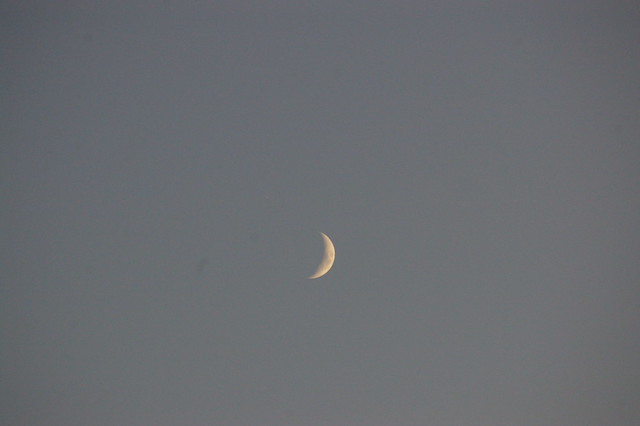
Despite a withering 103 degree temperature during the seven o’clock hour yesterday evening, I drug out my telescope and camera gear to the backyard in anticipation of an early evening planetary and lunar line-up. Terry grilled some chicken while I setup the scope, attached it to the portable battery and got the Autostar configured with the current date and time (almost straight up 8:00 pm). With forty minutes to go until sunset, I could clearly see the waxing crescent moon (see photo above), but the telephoto on my camera just couldn’t get me close enough to my lunar observing goal for the evening.
As I continue pursuing the Astro Quest observing award, created in 1995 by the ASKC Education Committee, I wanted to focus on the lunar section this month. The first item visible after a new moon happened to be the crater Hercules. Over the weekend, I researched all the lunar objects listed on the Astro Quest observing challenge, seeking images of the items first. I then determined I needed to find a lunar atlas. I have one for stars and deep sky objects (my handy Sky & Telescope Pocket Sky Atlas), but not a lunar one. Thanks to Google, I found the open source software called Virtual Moon Atlas, downloaded and installed it. I like it. The software makes it very easy to find features on the face of the moon and shows the current moon phase for my date/time and location.
I knew where to find the Hercules crater. Using my red dot finder scope, I honed the telescope in on the upper quadrant of the lit portion of the waxing crescent moon. Remembering to flip the image of the moon left to right in my head, I found the Hercules, and Atlas, craters easily. I spent several minutes using various eyepieces and barlows to zoom in for a closer look. I forgot to take a small portable table out with me to the backyard, so I didn’t have anything handy to take notes of my observations. I must get in the habit of doing this, if I plan to pursue other more stringent observing awards sanctioned by the Astronomical League.
I opted to mount my DSLR on the back of my telescope. I took a half dozen photos, none of which, upon downloading, were focused very well (grrrr). I selected the best of the bunch, cropped, labelled and uploaded it:
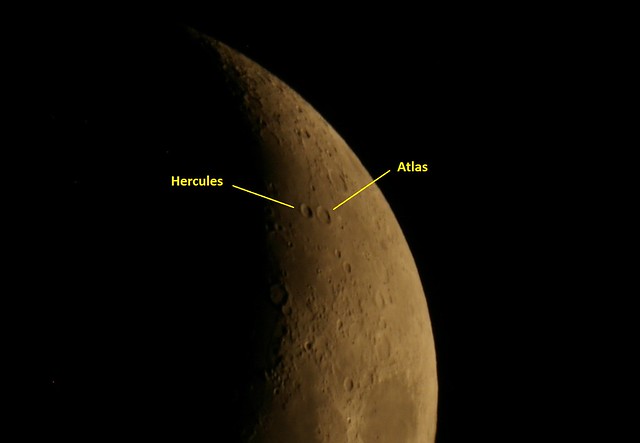
By this time, Terry had finished grilling supper, so I retired to the cool, air conditioned dining room to consume honey garlic grilled chicken and grilled Italian garlic bread with rice and Asian-style vegetables. He thoughtfully brewed some sun tea earlier in the day so I enjoyed two or three glasses of iced tea as well, knowing that I planned to return outside to the heat for more observing.
 After dinner, I returned to the backyard, where I could now see Saturn, Spica and Mars, as predicted by various astronomy alerts I’d received earlier in the day. I captured the southwestern horizon at 9:30 pm in Lansing, Kansas from Astronomy magazine‘s StarDome Plus Java applet to share here. I could see another star, besides Spica, above Mars, but I’m not exactly sure which one in the constellation Virgo it might have been.
After dinner, I returned to the backyard, where I could now see Saturn, Spica and Mars, as predicted by various astronomy alerts I’d received earlier in the day. I captured the southwestern horizon at 9:30 pm in Lansing, Kansas from Astronomy magazine‘s StarDome Plus Java applet to share here. I could see another star, besides Spica, above Mars, but I’m not exactly sure which one in the constellation Virgo it might have been.
Before shutting down the telescope and returning the camera to it’s tripod, and a normal lens with a wider field of view, I turned the ETX90 towards Saturn for a quick look. I did take one photo of the ringed gas giant, which turned out better than I thought it would:
I also tried again to see the polar ice cap on Mars, but the ETX90 just couldn’t provide enough light or magnification (through the eyepieces and barlows I own) to get much bigger than the head of a pin. I could clearly tell I was not looking at a star and that the color reflected back to my eye was a ruddy orangy pink, but I could not discern any other features of the Red Planet.
The moon shone just a tad too bright to easily capture the fainter Saturn and Mars in a single photograph. Of the dozen or so shots I took with various aperture settings, shutter and film speeds, I only found one that appeared adequate:
By ten o’clock, I had all the equipment back in the air conditioned house. I had voluntarily sweated outside during triple digit heat for nearly three hours to make a few astronomical observations. I spent a few blessedly cool moments sitting in front of the fan before downloading, reviewing, editing and uploading the photos I’d taken. Soon after, I fell into bed (near eleven o’clock and two hours past my bedtime), but tossed and turned all night long. When the alarm sounded at five o’clock, I slapped snooze three times until it forced me awake at half past the hour.
Another day, a Tuesday this time, and another triple digit heat index predicted for the Heart of America. Autumn can not arrive too soon.
And not much of it even purple.
I could easily see Venus, Jupiter and Aldebaran throughout the twenty minutes I vanely searched for the rising moon.
But I finally gave up looking for the last vestige of the waning moon with ten minutes left before sunrise.
And just before I took the camera off the tripod, I turned it north to capture some pink and purple tinged clouds.
But alas, I spied no moon amid the sea of haze washing up along the eastern horizon. Not surprising since the Kansas City area is under a heat advisory until Saturday evening (four days from now).
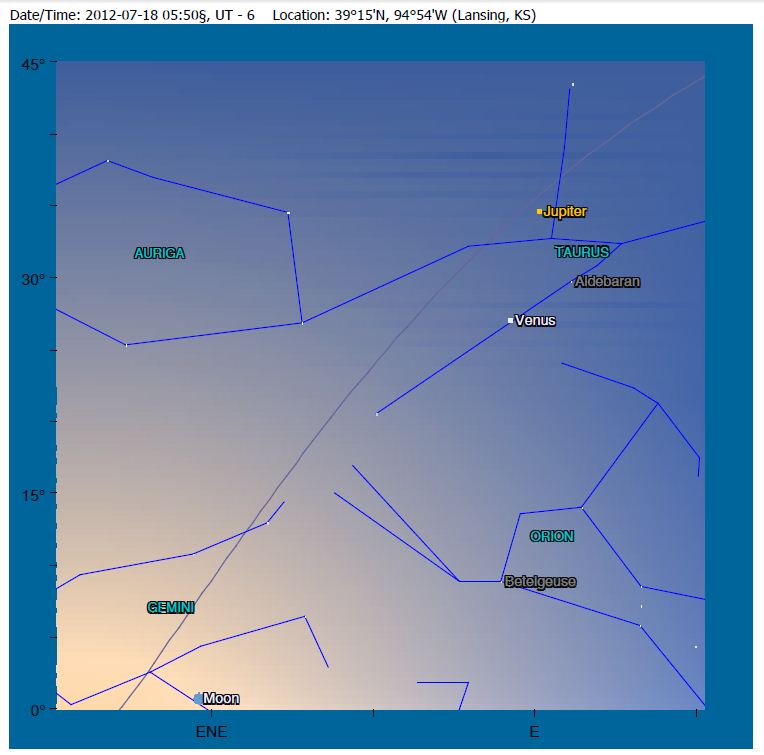 When I checked the star chart for the eastern horizon at moonrise later, I realized the moon wouldn’t even reach the five degree mark above the horizon before the sun rose. From the photos I took yesterday morning, I could discern the haze exceeded that height easily, which made an even thinner, dimmer crescent moon that much more difficult to find. I may have set myself an impossible task considering the amount of humidity in the atmosphere during the summer months in Kansas.
When I checked the star chart for the eastern horizon at moonrise later, I realized the moon wouldn’t even reach the five degree mark above the horizon before the sun rose. From the photos I took yesterday morning, I could discern the haze exceeded that height easily, which made an even thinner, dimmer crescent moon that much more difficult to find. I may have set myself an impossible task considering the amount of humidity in the atmosphere during the summer months in Kansas.
Perhaps I’ll have better luck next month capturing the elusive barest glimmer of the waning crescent moon.
I tossed and turned most of last night, dreaming about missing the opportunity to observe nearly the last shred of the dying crescent moon. I remember waking up at two o’clock, three o’clock and again at four o’clock, and struggling to return to sleep. Getting up that early would not have helped me observe the moon, since it wouldn’t rise above the horizon until 4:46 a.m. Central.
My cell phone buzzed me with my alert at ten minutes to five o’clock. I’d been staring up at the dark ceiling of my bedroom waiting for it to officially wake me up. I grumbled my way down the stairs, with Apollo in tow, and greeted my husband and our new Rottweiler, Lexy. I only took a moment to slip on my flip-flops, grab the camera gear, my purse and the van key. I drove a block and a half up the hill to the dead end in front of City Hall and just like I did two days ago, setup my tripod in the middle of the street.
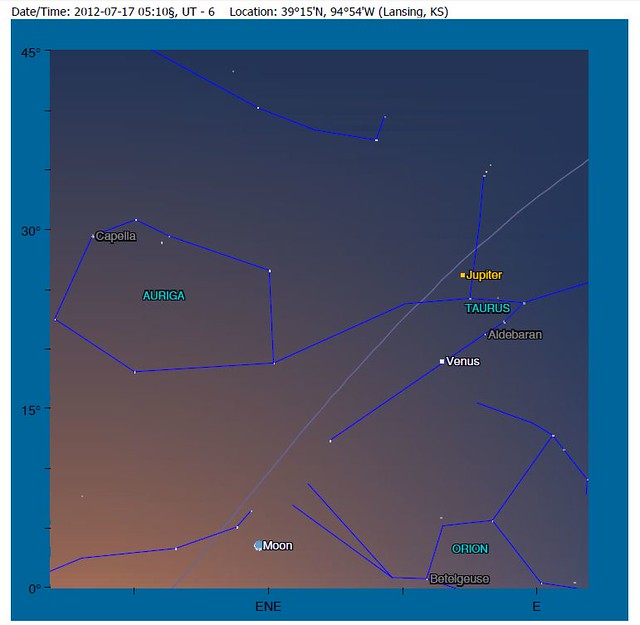
I could clearly see the sliver of the waning crescent moon, just a few degrees (less than five degrees actually) above the eastern horizon. The sky appeared to be only minimally hazed. I began taking photos at 5:04 a.m. and tried various automatic settings and then revert to manually manipulating the shutter, aperture and finally the ISO, setting it to 800 (something I don’t like doing because it sacrifices pixels and detail for more light). Here is the unaltered series of photos I took, stopping at 5:13 a.m. this morning (click the image to view rest of album):
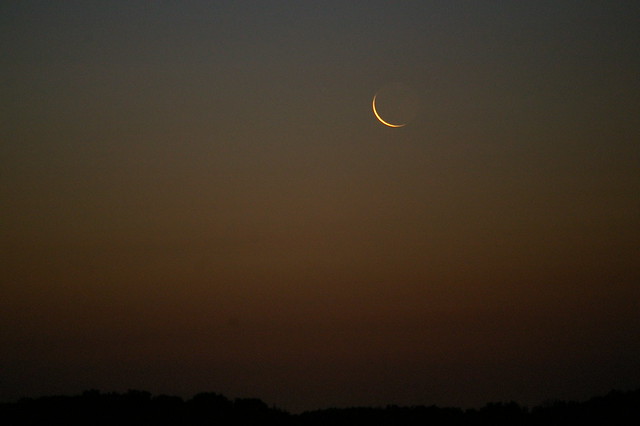
I may try again tomorrow morning, but I fear the twilight will wash out any chance of seeing the extremely thin crescent of a moon less than eighteen hours away from being reborn as a new moon. Moon rise tomorrow morning occurs at 5:43 a.m. Central, but twilight begins at 4:15 a.m. Sun rise will occur at 6:08 a.m. so I would have less than a half hour to spy an even thinner crescent moon amid the growing glare of the rising sun.
I also plan to attempt to capture the first sliver of the new moon on Thursday evening, but I don’t think I will be successful. The sun sets at 8:42 p.m. and the moon sets at 8:50 p.m., just eight minutes later. The new moon occurs near midnight (about a half hour before straight up midnight) during night the 18th (tomorrow).
I need my head examined. Why else would I suddenly sit up in bed and immediately head to a window in the darkest hour of the night, just to see if an astronomical conjunction was visible yet? And that’s exactly what I did this morning, without the aid of an alarm clock. Some internal portion of my brain must be tapped into some universal system (let’s hope it’s not that Dark Energy that’s making the cosmological headlines lately), because I woke up at 3:55 a.m. earlier today, just so I could photograph two planets, a star and a crescent moon.
A quick peak out my second story east facing window showed something bright glittering through my large oak tree’s leaves. For a better look, I went out the front door and walked halfway down the driveway. Yep, I could clearly see the crescent moon, Jupiter above, and Venus below, as well as the star Aldebaran in the constellation Taurus (although that was the only star I could see in that constellation with my blurry bleary sleepy eyes).

I went back inside and grabbed my camera gear and the keys to the van. I remembered my purse, since I planned to setup the tripod in the cul-de-sac in front of Lansing City Hall and the Police Department. I’ve been questioned more than once by the local ‘protect and serve’ brigade while attempting astrophotography on their front lawn.
I took a couple of shots with the normal lens, but quickly determined I really needed the telephoto. Once I switched the lenses, I could zoom in and capture just the four primary objects in one frame. I took a half dozen photos before returning the gear to the van. At least one police car did cruise by, but he probably didn’t see me ensconced in the dark dead end to his right as he turned left down the hill.
Once I got back home, I went back to bed. Five hours later, I woke up and thought to look at the photos I’d taken while half asleep. I settled on the second to last one I took. Here is that photo (twice … once without labels and once with):
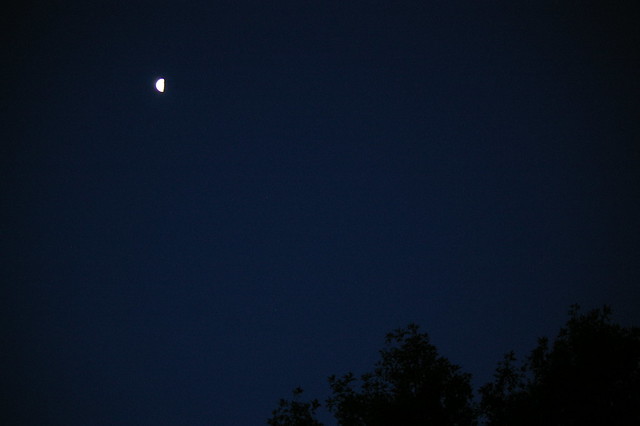
I let Apollo out this morning and looked up (like I always do) and realized the sky was unusually clear, free of haze or clouds. I vaguely remembered reading an astronomy alert on Monday about Jupiter or Venus being less than ten degrees from a bright star (which one I couldn’t remember off the top fo my head). So, I left Apollo in the back yard and traversed the house to the front door on the east side. I stepped outside and had to walk down the steps to get out from under my large black oak tree, which blocks all of the eastern horizon when you look out the front door or windows of my house. Up and to the southeast I easily found the waning moon (see photo above). Turning back to the east, I found a very bright Venus and a somewhat less bright (but not by much) Jupiter directly above it. And just to the lower right of Venus, I could barely see a star twinkling.
I went back in the house and grabbed my camera. The tripod stayed locked in the trunk of the car. I just hoped I could keep steady enough to capture the ‘morning stars’ from the driveway. I took half a dozen shots of Jupiter and Venus and three or four of the waning moon. Then I went inside to review the results.
All but the last photo of Jupiter and Venus were blurry from not using a tripod. Only one photo of the moon, done with some manual fiddling with the shutter and aperture proved to be passably viewable.
I hopped on the Astronomy.com website to access their Star Dome Plus subscriber only star atlas Java application. I needed to determine the name of the star faintly sparkling next to bright Venus. I set the app to look at 45 degrees of the eastern horizon at the time I took the photo (5:35 a.m. Central) and discovered Aldebaran of the constellation Taurus to be the star near our sister planet. Here’s a screenshot of the eastern horizon courtesy of Star Dome Plus:

I quickly edited my one good photo of the ‘morning stars’, rotating the orentation from landscape to portrait and adding some text labels to identify the objects observed. Here are both the unlabelled and labelled versions of that photo:
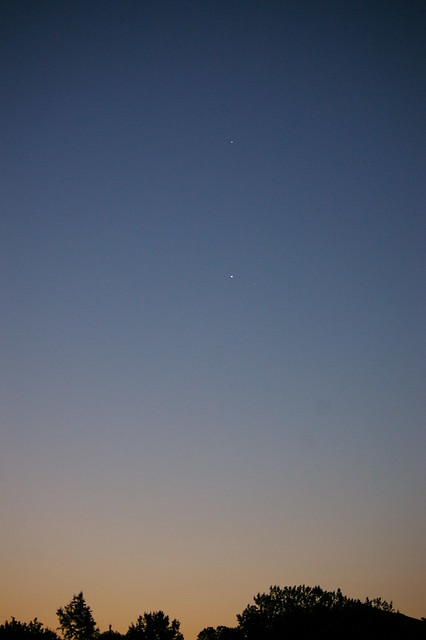
I did remember to let Apollo back in from his morning soujourn through the backyard. He turned his nose up at his breakfast and climbed up on the couch for his morning nap.
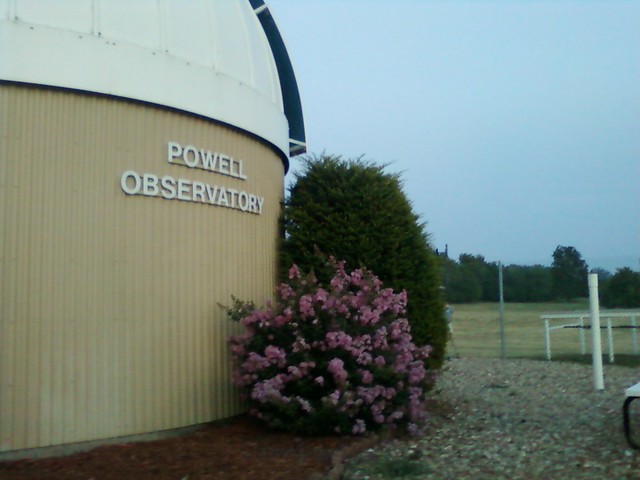 Saturday evening I headed south to Louisburg to volunteer for my second scheduled night of the 2012 Powell Observatory public season. My dad decided to tag along, to enjoy the show and help keep me awake for the long drive home. We left Lansing about twenty minutes after five and my car’s external thermometer reported 106 to 107 degrees, which has been our afternoon average for about a week now, give or take two or three degrees either way. We stopped in Bonner Springs to grab a quick, cool sandwich from Subway and returned to the highway just shortly after six o’clock. I needed to be at Powell Observatory by seven o’clock to help prepare the facility for the weekly public program and observing night.
Saturday evening I headed south to Louisburg to volunteer for my second scheduled night of the 2012 Powell Observatory public season. My dad decided to tag along, to enjoy the show and help keep me awake for the long drive home. We left Lansing about twenty minutes after five and my car’s external thermometer reported 106 to 107 degrees, which has been our afternoon average for about a week now, give or take two or three degrees either way. We stopped in Bonner Springs to grab a quick, cool sandwich from Subway and returned to the highway just shortly after six o’clock. I needed to be at Powell Observatory by seven o’clock to help prepare the facility for the weekly public program and observing night.
As we approached Louisburg from the north, I noticed a definite increase in the wind, so much so that my car was jostled several times. At the same time, I noticed a significant drop in the external temperature. By the time I exited US-69, the thermometer read 92 degrees, and was still falling. Except for early mornings the past couple of weeks, I had not seen or felt such low temperatures while the sun still shone. I pulled into the west observing field parking area and realized I was again the first person to arrive. Since the temperature had dropped, I turned off the car and opened all the windows. The breeze felt incredibly refreshing.
My team leader arrived within a few minutes and I received my Powell Observatory ‘Staff’ T-shirt, which I changed into as soon as the building was unlocked. I helped setup the class room for the program, ‘Sounds of Space.’ Another ASKC member arrived and setup his ten-inch Dobsonian for solar observing and I caught a glimpse of some great sunspots before our public guests began arriving. The clouds provided some dramatic solar observing situations.
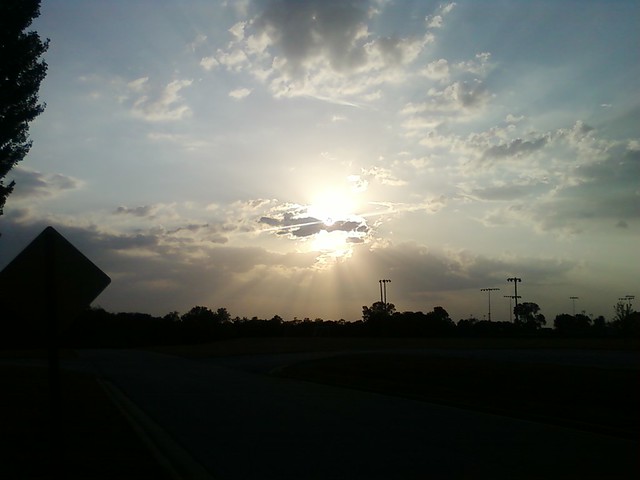
I repeated my role as gatekeeper and accepted donations from the public and queried them for their ZIP codes to record for future grant petitions. The first group of twenty-five guests began the ‘Sounds of Space’ program at 8:30 p.m., but I soon had at least that many waiting for the second showing. At one point as I sat waiting for more guests to arrive, what I thought was a stray dog wandered into the observing field, soon followed by three horses, two with riders and a third colt between them. They trotted across the field to the west, with the dog trailing after, riding off into the sunset … literally.

As the sky continued to darken, despite a few wispy clouds, we opened the dome so those waiting for the next program could observe Saturn and a globular cluster found in the constellation Scorpius. I didn’t get a chance to look at the cluster through the 30-inch scope, but I believe they looked at M4, which is near the bright star Antares.
We ended up having nearly ninety public guests Saturday evening and ran a third showing of our program. After the last two guests had left the dome a bit after eleven o’clock, I quickly snuck a peak at the Ring Nebula in the constellation Lyra, one of the 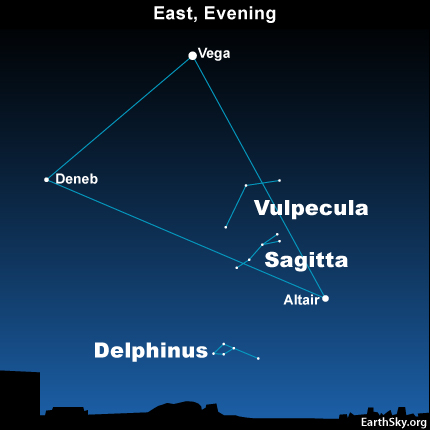 Messier Objects I’ve been trying go get a glimpse of for quite some time. Lyra is also home to the very bright star Vega, one of the three stars that form the Summer Triangle.
Messier Objects I’ve been trying go get a glimpse of for quite some time. Lyra is also home to the very bright star Vega, one of the three stars that form the Summer Triangle.
As the final guests drove away, my team members and I began cleaning the building and storing chairs, tables and other items for the next Saturday. I signed myself out of the Observatory at 11:35 and gathered up my dad for the long drive home. He related information he’d gleaned from another team members about various types of Dobsonian telescopes and helped keep me alert as we sped north towards Leavenworth County.
Next week, we present a program on ‘Our Amazing Moon’ and the following week we’ll pose the question ‘Is There Life Out There?’ We look forward to showing you the astronomical sights (and sounds).
Until then, Keep Looking Up!
Every year I look forward to the summer solstice in June, not because I’m in love with the heat and humidity that pervades Kansas, but rather because it signals the beginning of the shorter days and longer nights. Until recently, my amateur astronomy goals didn’t include solar observing, but twice in the last month I’ve been drawn into observing a solar eclipse and the transit of Venus. I can safely say I’ve had my fill of the sun for the foreseeable future.

This evening at 6:09 p.m. CDT, less than an hour after I return home from work, the sun will reach the highest position in the sky, as seen from the Northern Hemisphere. Tomorrow, and each succeeding day thereafter, the sun will ‘fall’ ever so slowly back towards the south (most notable at dawn or dusk). Someday I hope to visit the far north, perhaps Canada or Alaska and experience the midnight sun, or rather a full day of sun, sans sunrise or sunset.
But for the next six months, I will take advantage of the lengthening nights to achieve some of my other astronomical observing goals, provided the clouds, humidity and winds cooperate.
In the short term, though, my yard and trees could really use some rain. You won’t catch me lighting a midsummer bonfire in my backyard tonight! Too much chance of everything, including the house, going up in flames.
Welcome to Summer!
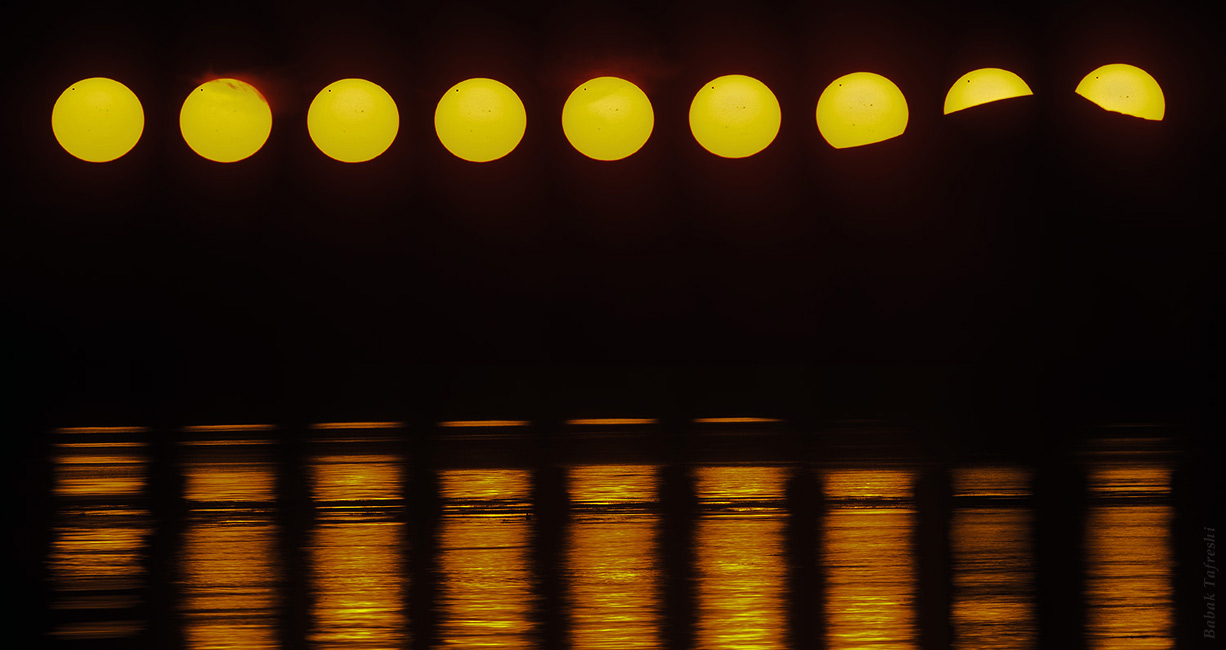
I decided to take a day of vacation from work yesterday. Even though the Transit of Venus wouldn’t start until shortly after five o’clock in the afternoon, I didn’t want to miss any of it, especially the beginning. I wiled away the day reading, baking bread and making strawberry shortcake. I also tested the scope (but not the camera) around noon, getting a clear picture in my mind of the current configuration of our nearest stellar neighor.
As the clock approached four in the afternoon, I laid out all my equipment, sunscreen, sunglasses, umbrella and collapsable chair, making sure I had everything I would need for an observing session that would last several hours on a slightly warmer than normal and sunny June afternoon. My prayers had been answered in part, at least, for clear skies (releatively clear, except for some humidity, haziness and wispy stratus clouds). I proved to be my own worst enemy, though, because while washing my hair, I managed to get an entire palmful of shampoo in my right eye, which happens to be my ‘good’ eye – the one I use to focus and observe with. My eye watered for the rest of the day, but at least didn’t appear to have any problems focusing.

I packed everything in the car and had my husband drive me to my previously selected observing spot. It’s my new favorite location for observing and photographing day-time astronomical events that require an unobstructed view of the western horizon (and it’s close to home so I don’t spend time and gas money to get there). In the last few weeks from this spot, I’ve observed a solar eclipse, earthshine on the moon (with Venus nearby), a lunar eclipse and yesterday my first (and only) Venus transit. I unpacked the equipment, said goodbye to my husband (who would return later to catch a glimpse of the ‘black dot’ that would be Venus crossing the sun) and started setting up the scope. My dad joined me, sometime between 4:30 and 5:00 p.m., as he got tied up with rush hour traffic on US-73 southbound from north Leavenworth to south Lansing.
I had parked the scope when I used it around noon, leaving it in a polar mount configuration. I knew I wouldn’t be able to re-align it to Polaris when I transported it from my backyard to this other site, but I could get ‘in the ballpark’ enough to track the sun and take photographs. The most challenging aspect of taking photographs through the Meade ETX-90 with the Pentax K100D attached to it is focusing. The viewfinder on the camera presents a very small ‘live’ view of the object (in this case the filtered image of the sun). The sunspots, which appeared very large and distinct when observing through the telescopes eyepiece under magnification, were tiny pinpricks through the camera. Focusing became easier once the large black dot of Venus appeared, but before that, resolving the sunspots proved troublesome. With that in mind, here’s a photo from immediately prior to the transit of Venus commencing:
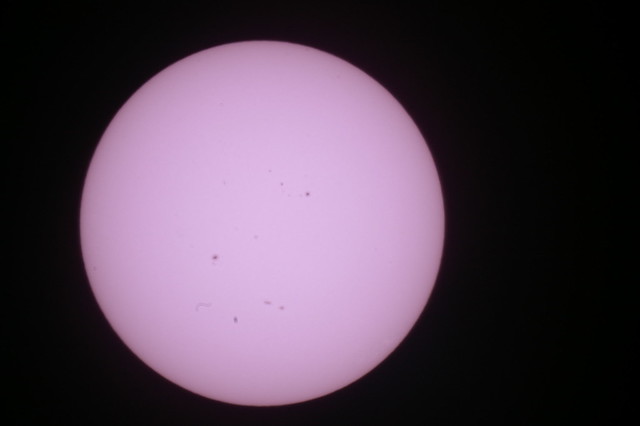
I choose this location also in the hopes that people would see me on the hill overlooking Main Street and stop by to have a look (or at least ask me what the heck I thought I was doing so I could then explain and convince them to take a look). Over the course of the next three hours, I had between fifteen and twenty people stop and take a look at the transit through my telescope. The first group to stop had seen me there before, back in May for the solar eclipse. I asked them to wait a couple of minutes because I was taking a serious of photographs to capture the first and second contacts of Venus:

One of the last group included an entire family who had seen me on their way to a baseball game (for their young son) and stopped on the way back after the game. They pursuaded their grandmother to leave the car and take a look. By that time though, the sun had entered some thicker clouds and was close to setting, so the light getting through the solar filter created a dim red hazy image, but Venus’ black sillouette was still clearly visible.
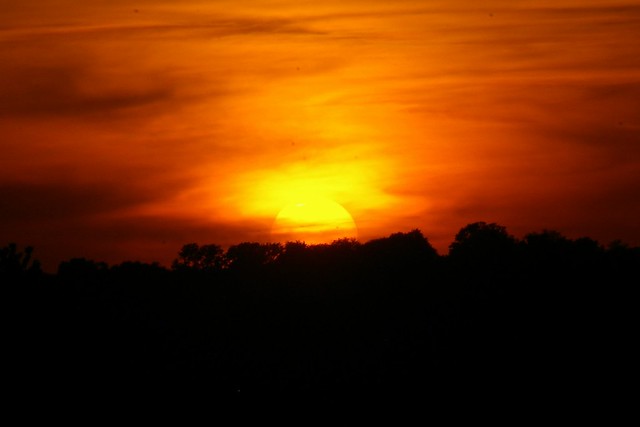
After the sun set, Dad and I packed up the equipment and said our goodbyes. We were both tired, from standing, sometimes bending over, occasionally sitting, but always baking in the late afternoon June sun. I went home, ate some leftovers, grabbed 140 photos off my cameras memory card and selected one or two to upload and share with friends and family. I didn’t have the energy last night to review so many photos. I called my daughter, who lives in Texas, to see if she had a chance to witness the transit. She reported she did, as her university setup several scopes near their Environment Sciences lab building and she got to see the sun through a hydrogen-alpha filter (which I am saving up for as they are not cheap). I also tuned in to NASA’s live feed both on my laptop and via DirecTV (channel 289) for a few minutes before succumbing to my need for sleep.
First thing this morning when I awoke, I began sifting through the photos and settled on thirty-nine good shots to upload and share. I discovered, though, that I have some debris on my camera mirror and will need to have it cleaned. See if you can find the debris that looks like a sunspot but travels around the surface of the sun (but not the frame of the picture).
Later this week, I will attempt to qualify for an observing certificate from NASA using the Paralax Activity Method #1 (I can’t do the other two because I only witnessed about half of the transit before the sun set). But first I’ll read and review the Mathematics of the Transit of Venus to make sure my aging brain remembers college math.
I am so glad I had the opportunity to witness the Transit of Venus. I sincerely hope you took advantage to sneak a peak. Only our grandkids (or great-grandkids) will see the next one, in 2117.
I set my alarm for 4:30 a.m. before I fell asleep Sunday night. The alarm woke me and I stumbled to the west facing window in my bedroom and couldn’t find the full moon. I assumed, blearily and incorrectly, that the moon must be hidden by clouds. I crossed over to my library and its east facing window and couldn’t see any stars (not unusual though that near to dawn and with the amount of light pollution I suffer from). I went back to bed.
My regular alarm woke me at 5:00 a.m. sharp like it always does. I checked my windows again, but this time my east facing window showed a mostly blue sky. That gave me a jolt, almost like a hot cup of coffe. I immediately began rushing around the house, throwing on clothes and grabbing my camera bag. I jumped in the car and drove to my closest vantage poitn with an adequate western horizon view. I could see the moon, already partially eclipsed, but obscured by some thin clouds and lots of haze.
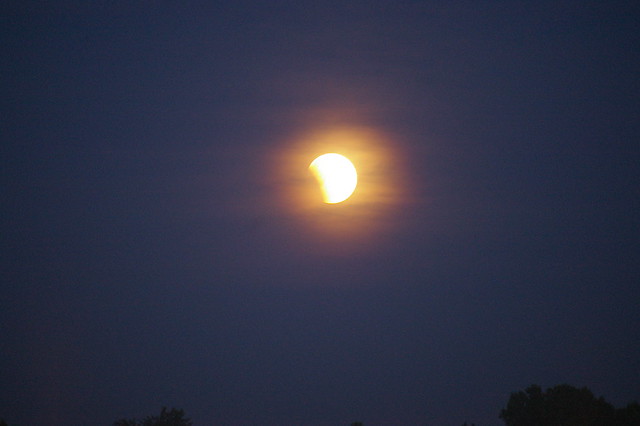
I wondered to myself why the moon seemed to be setting in the southwest. I stood in the same spot from where I watched and photographed the solar eclipse just two weeks before and at that time, both the moon and the sun set almost due west. I did spend some time today trying to find an explanation or graph or plot to explain to me visually why the moon’s orbit diverged so greatly over a half month. I’m still searching for a satsifactory answer.
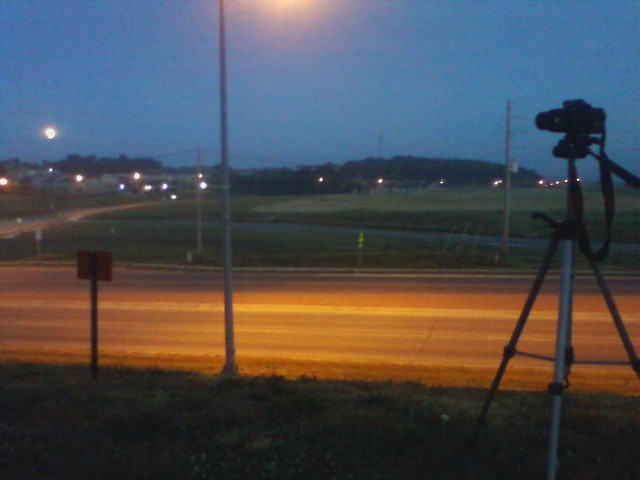
I settled in to a routine, snapping photos every few seconds or minutes, sometimes adjusting the shutter speed, or the aperture. I occassionally switched back to autonatic mode, letting the camera decide for itself what settings to use (usually producing photos I didn’t care for). By 5:30, the moon had almost set behind the hill to the southwest of my location.
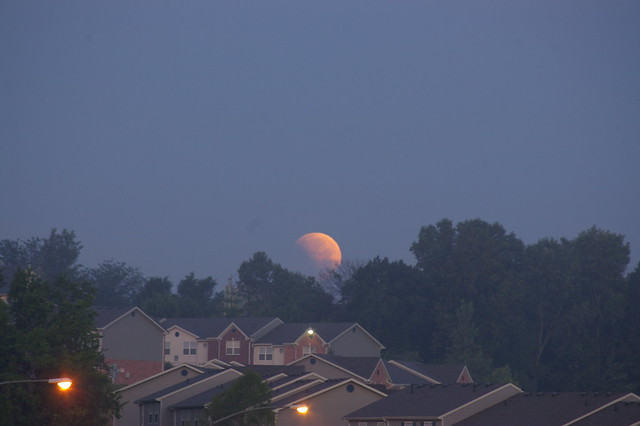
I took a total of sixty photos, not including the one above taken with my call phone, so if you are a true glutton for punishment, click on the photos above to review the entire album. I didn’t have time this morning before leaving for work to review and filter out the obvious duds.
If I had realized the moon would set so early, I would have driven to a better site where I didn’t have a tall hill between me and the southwestern horizon. I mistakenly assumed the moon would set in the west and opted to use a location only a few blocks from my home.
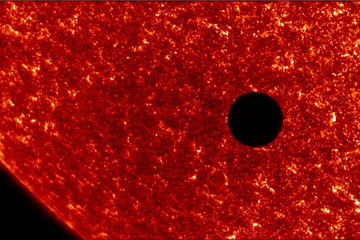 Tomorrow, I will be at the same spot, but at a different time, to observe and photograph the Transit of Venus. You should be able to see me and my telescope from Main Street in Lansing during rush hour tomorrow afternoon. Stop by and have a look at a once-in-a-lifetime event. If you live in the Kansas City metro area, you have multiple locations from which to view the transit (click here for more information thanks to the Astronomincal Society of Kansas City).
Tomorrow, I will be at the same spot, but at a different time, to observe and photograph the Transit of Venus. You should be able to see me and my telescope from Main Street in Lansing during rush hour tomorrow afternoon. Stop by and have a look at a once-in-a-lifetime event. If you live in the Kansas City metro area, you have multiple locations from which to view the transit (click here for more information thanks to the Astronomincal Society of Kansas City).